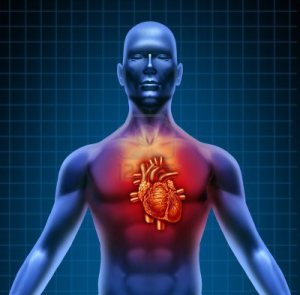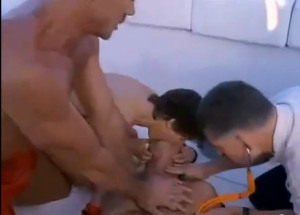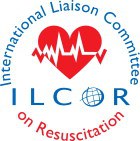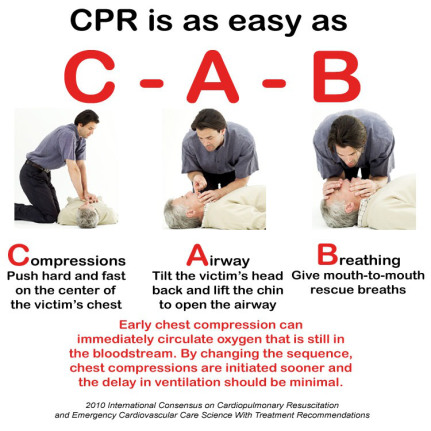Welcome to CPR Training.
1. The Basics
2. CPR Statistics
3. How it works
4. Hands-only CPR
5. Scene Safety
6. CPR Guidelines 2015 Updates
7. How to Perform CPR for Adults, Children, and Infants
8. Animal CPR
9. Testing
1. The Basics
CPR stands for Cardiopulmonary Resuscitation.

Performing CPR preserves brain function long enough for further measures to restore spontaneous blood circulation and breathing in a person who is in cardiac arrest.
CPR is needed for any person who is unresponsive, is not breathing, or does not have abnormal breathing.
Breaths are provided by exhaling into the mouth or nose of the victim.
Devices can be used that automatically push air into the victim’s lungs. This is known as artificial respiration.
The 2010 and 2015 American Heart Association guidelines recommend an emphasis on high-quality chest compressions as opposed to rescue breaths or artificial respiration.
Hands-only CPR, where only chest compressions are performed, is recommended for untrained rescuers.
2. CPR Statistics
More lives each year are lost to Cardiovascular Disease than any other disease. Over 800,000 people die each year from cardiovascular disease.
CPR Effectiveness
Performing CPR preserves the body for advanced life support including defibrillation.
CPR by itself results in few lives saved.
CPR is meant to prolong life until the defibrillator is applied to the victim.

Studies have shown that CPR performed immediately and quickly followed by defibrillation within 3–5 minutes of sudden Ventricular Fibrillation cardiac arrest can greatly improve the victim’s chance of survival.
In Seattle Washington where CPR training is widespread and defibrillation quickly follows by EMS, the survival rate is about twenty percent for all causes. In other cities like New York without widespread CPR quickly followed by defibrillation, the survival rate is about five percent.
Chances of receiving CPR in time
CPR is most effective when it is performed within six minutes after blood flow stops. Permanent brain cell damage occurs when fresh blood then infuses the cells. The brain cells then become dormant in approximately 4–6 minutes in an oxygen deprived environment. At this stage, the brain cells cannot survive new oxygen provided by a rescuer during a resuscitation attempt.
3. How It Works
Pathophysiology
CPR is performed on a person in cardiac arrest to oxygenate the blood and maintain a cardiac output that vital organs can survive.


Blood circulation and oxygenation transport oxygen to the human tissues.
The human brain can sustain damage without blood for approximately 4 minutes. Irreversible damage occurs after approximately 7 minutes.
CPR is most effective if it is performed within approximately seven minutes of the stoppage of blood flow. In the time, the heart rapidly loses the ability to maintain a normal rhythm.
Low body temperatures can prolong the amount of time the brain can survive.
Performing CPR provides enough oxygen to reach the brain in order to delay brain stem death and allow the heart to remain responsive to defibrillation.
CPR alone is highly unlikely to restart a victim’s heart.
The main purpose of CPR is to restore partial flow of oxygenated blood to the heart and to the brain.
The goal of CPR is to delay tissue death and to allow more time for the successful resuscitation of the victim without permanent brain damage.
Administration of an electric shock to the victim’s heart using a defibrillator is usually needed to restore a normal heart rhythm.
CPR succeeds in that it induces a heart rhythm that may be shockable by using a defibrillator.
CPR should be continued until the victim begins breathing or is declared dead.
4. Hands-Only CPR

Compressions only CPR
Compressions-only also known as hands-only CPR is a technique involving chest compressions alone. The American Heart Association recommends hands-only CPR for untrained lay public because it is easier to perform. The American Heart Association hopes hands-only CPR will increase the chances of an untrained lay person performing CPR.
There is a higher success rate for adult outside of the hospital when compressions-only CPR by the lay public is performed.
Children receiving compressions-only CPR have had the same outcomes as children who have received no CPR.
The American Heart Association recommends practicing or humming to the beat of the song Staying Alive by the Bee Gees because the song provides an ideal rhythm of “beats-per-minute” for hands-only CPR.
5. Scene Safety


Remember SUB:
S – Survey the Scene to make sure is safe for you and the victim.
U – Check for Unresponsiveness. Tap the victim on the shoulder and shout “Are you okay?”
B – Check for Breathing.
If the victim is not breathing, start CPR and call 911.
6. CPR Guidelines 2015 Update

The American Heart Association and International Liaison Committee on Resuscitation updated their CPR guidelines most recently in 2015.
Emphasis on chest compressions including chest compression rate, depth and chest recoil were updated.
Lay rescuers who are untrained should provide hands-only (compressions only) CPR whether or not a dispatcher is providing guidance. CPR should be continued until an AED arrives or until a higher trained rescuer arrives. Additionally, if the trained lay rescuer can provide rescue breaths, they should be added in a 30 compressions to 2 breaths ratio. CPR should be continued until the victim moves, EMS takes over or an AED arrives and is ready for use.
Rescuers should provide chest compressions at a rate of 100 to 120 per minute with a chest compression depth of 2 inches and no more than 2.4 inches for an average adult. Rescuers should avoid leaning on the victim’s chest in between compressions so that the full chest wall is allowed to recoil for adults in cardiac arrest.
Use of social media to call for rescuers. Communities should consider incorporating social media technologies that call for rescuers who are nearby to a victim and who are willing and able to perform CPR.
Community lay rescuer AED Programs. PAD programs should be implemented in public areas where there is a higher likelihood of a witnessed cardiac arrest (eg. Casinos, sports facilities, airports).
In 2010, the emphasis was shifted to the importance of high quality compression rate and depth without overly ventilating.
The order of CPR was changed from “ABC”, or Airway, Breathing, and Chest Compression, to “CAB”, or Chest Compressions, Airway, and Breathing.
This is the case except for newborns. Another exception to the new recommendation are for those who are believed to be in a respiratory arrest from cases such as drowning.
The most essential components of CPR are steady consistent chest compressions with the correct speed and compression depth, while completely relaxing pressure between chest compressions, and not overly ventilating the victim.
7. How to perform CPR

Remember CAB:
C – Compressions.
- Place the heel of one hand on the center of the chest and place the other hand on top, interlocking your fingers.
- Press straight down at least 2 inches deep 30 times at a rate of 100 times per minute for adults and children.
- For infants, place 2 fingers on the breastbone right below the nipple line and place the other hand on the forehead.
- Press straight down at least 1/3 depth of the chest or about 1 ½ inches deep 30 times at a rate of 100 times per minute.
A – Airway.
- To open the airway, tilt the head and lift the chin by placing 1 hand on the forehead and 2 fingers on the bottom of the chin.
B – Breathing.
- Pinch the nostrils closed for adults and children and provide 2 breaths so the chest rises.
- For infants, seal your mouth around the nose and mouth and provide 2 small breaths.
8. Animal CPR

Administering CPR to animals is virtually identical to CPR for humans, though the breaths are usually provided through the animal’s nose.
To avoid the risk of being bitten, only perform CPR on unconscious animals.

